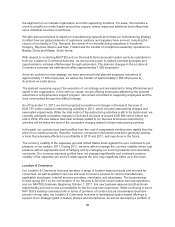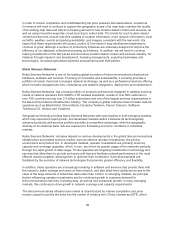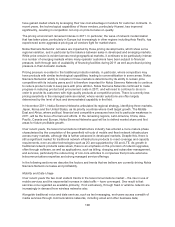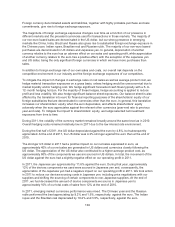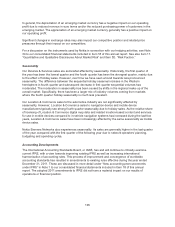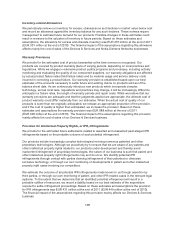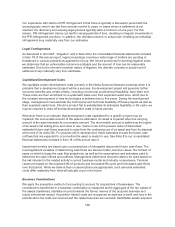Nokia 2011 Annual Report Download - page 106
Download and view the complete annual report
Please find page 106 of the 2011 Nokia annual report below. You can navigate through the pages in the report by either clicking on the pages listed below, or by using the keyword search tool below to find specific information within the annual report.Foreign currency denominated assets and liabilities, together with highly probable purchase and sale
commitments, give rise to foreign exchange exposure.
The magnitude of foreign exchange exposures changes over time as a function of our presence in
different markets and the prevalent currencies used for transactions in those markets. The majority of
our non-euro based sales are denominated in the US dollar, but our strong presence in emerging
markets like China, India, Brazil and Russia also gives rise to substantial foreign exchange exposure in
the Chinese yuan, Indian rupee, Brazilian real and Russian ruble. The majority of our non-euro based
purchases are denominated in US dollars and Japanese yen. In general, depreciation of another
currency relative to the euro has an adverse effect on our sales and operating profit, while appreciation
of another currency relative to the euro has a positive effect, with the exception of the Japanese yen
and US dollar, being the only significant foreign currencies in which we have more purchases than
sales.
In addition to foreign exchange risk of our own sales and costs, our overall risk depends on the
competitive environment in our industry and the foreign exchange exposures of our competitors.
To mitigate the impact of changes in exchange rates on net sales as well as average product cost, we
hedge material transaction exposures on a gross basis, unless hedging would be uneconomical due to
market liquidity and/or hedging cost. We hedge significant forecasted cash flows typically with a 6- to
12- month hedging horizon. For the majority of these hedges, hedge accounting is applied to reduce
profit and loss volatility. We also hedge significant balance sheet exposures. Our balance sheet is also
affected by the translation into euro for financial reporting purposes of the shareholders’ equity of our
foreign subsidiaries that are denominated in currencies other than the euro. In general, this translation
increases our shareholders’ equity when the euro depreciates, and affects shareholders’ equity
adversely when the euro appreciates against the relevant other currencies (year-end rate to previous
year-end rate). To mitigate the impact to shareholders’ equity, we hedge selected net investment
exposures from time to time.
During 2011, the volatility of the currency market remained broadly around the same level as in 2010.
Overall hedging costs remained relatively low in 2011 due to the low interest rate environment.
During the first half of 2011, the US dollar depreciated against the euro by 4.8%, but subsequently
appreciated. At the end of 2011, the US dollar was 4.2% stronger against the euro than at the end of
2010.
The stronger US dollar in 2011 had a positive impact on our net sales expressed in euro, as
approximately 40% of our net sales are generated in US dollars and currencies closely following the
US dollar. The appreciation of the US dollar also contributed to a higher average product cost, as
approximately 60% of the components we use are sourced in US dollars. In total, the movement of the
US dollar against the euro had a slightly negative effect on our operating profit in 2011.
In 2011, the Japanese yen appreciated by 11.6% against the euro. During that year, approximately
12% of the devices components we used were sourced in Japanese yen and, consequently, the
appreciation of the Japanese yen had a negative impact on our operating profit in 2011. We took action
in 2011 to reduce our devices sourcing costs in Japanese yen, including price negotiations with our
suppliers and shifting the sourcing of certain components to non-Japanese suppliers. At the end of
2011, we had decreased the amount of device components we source in Japanese yen to
approximately 10% of our total costs of sales from 12% at the end of 2010.
In 2011, emerging market currencies performance was mixed. The Chinese yuan and the Russian
ruble performed the best appreciating by 9.2% and 1.5%, respectively, against the euro. The Indian
rupee and the Brazilian real depreciated by 10.2% and 3.5%, respectively, against the euro.
104




